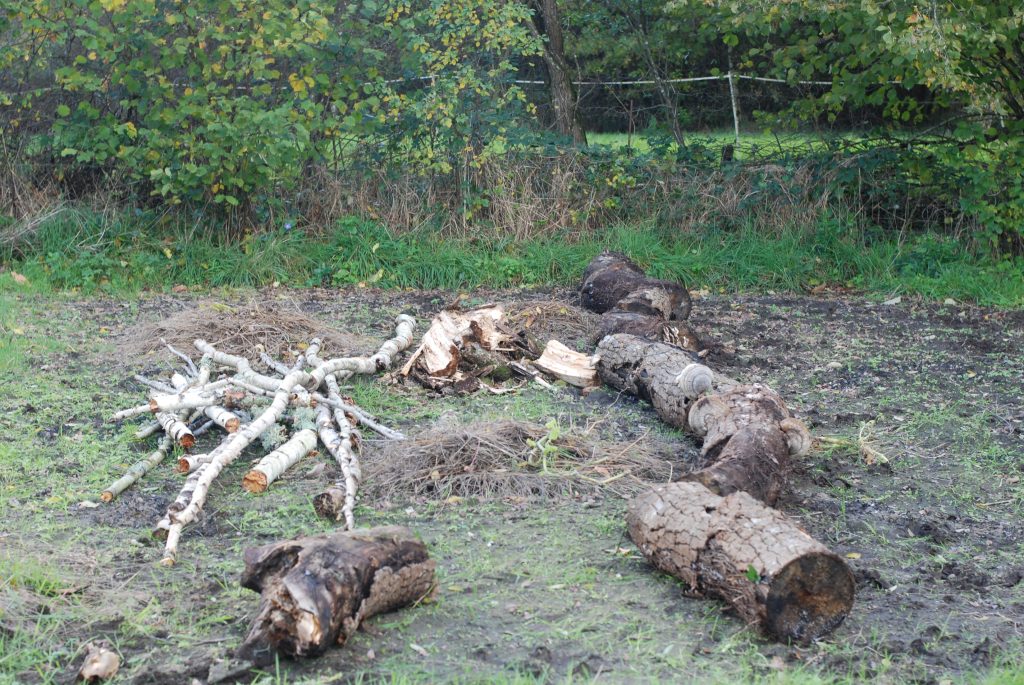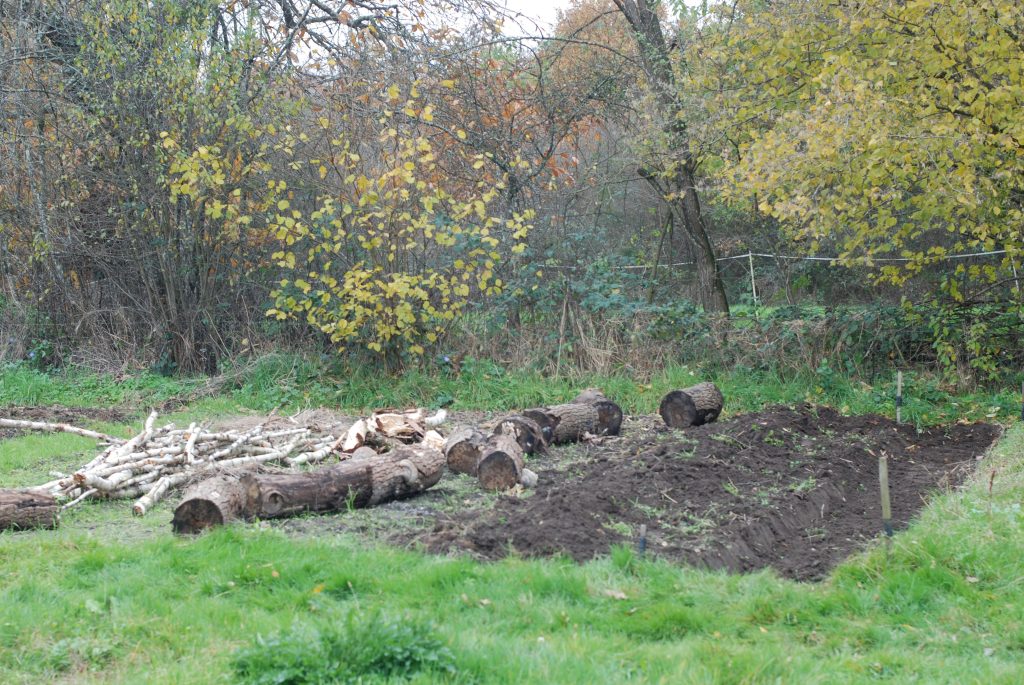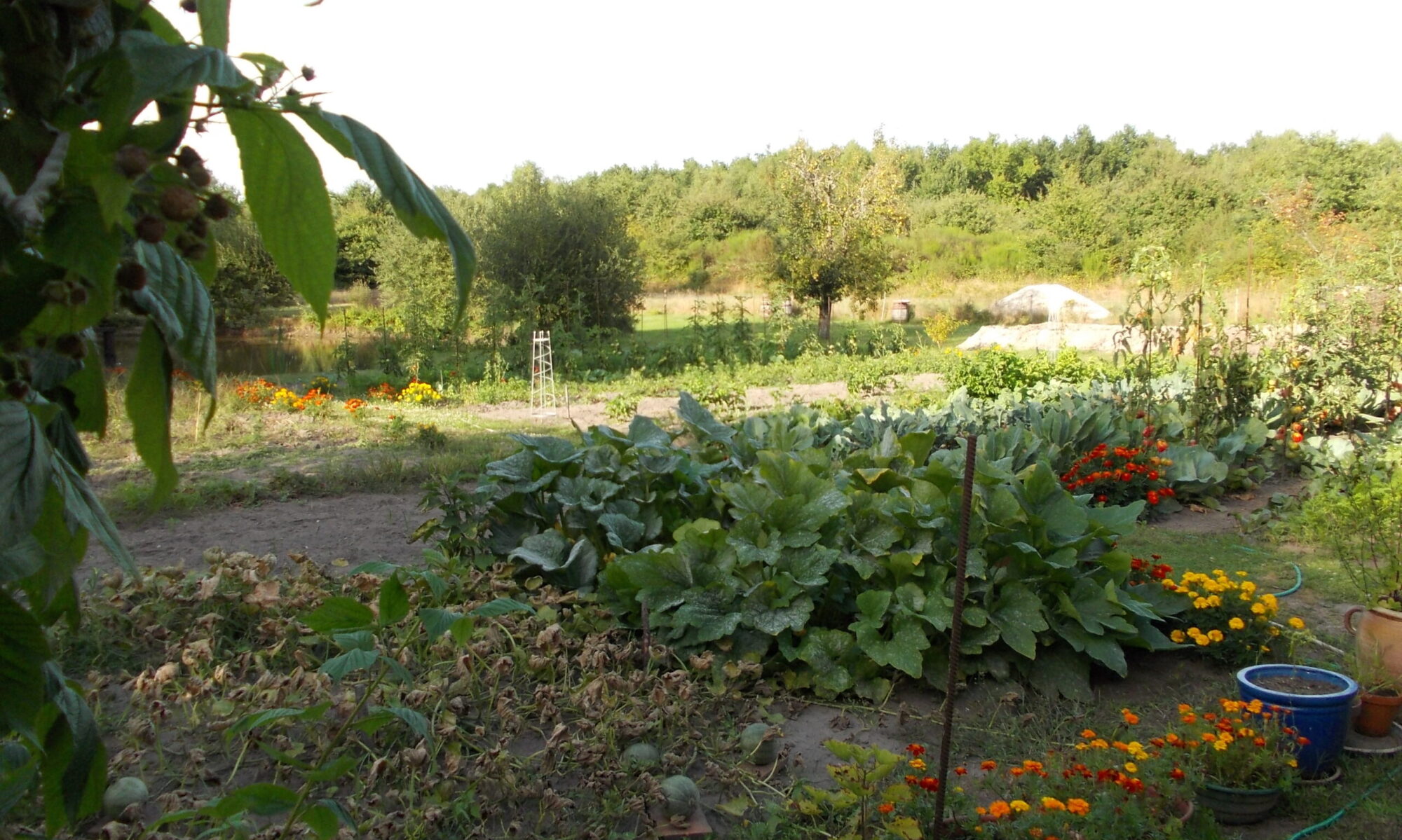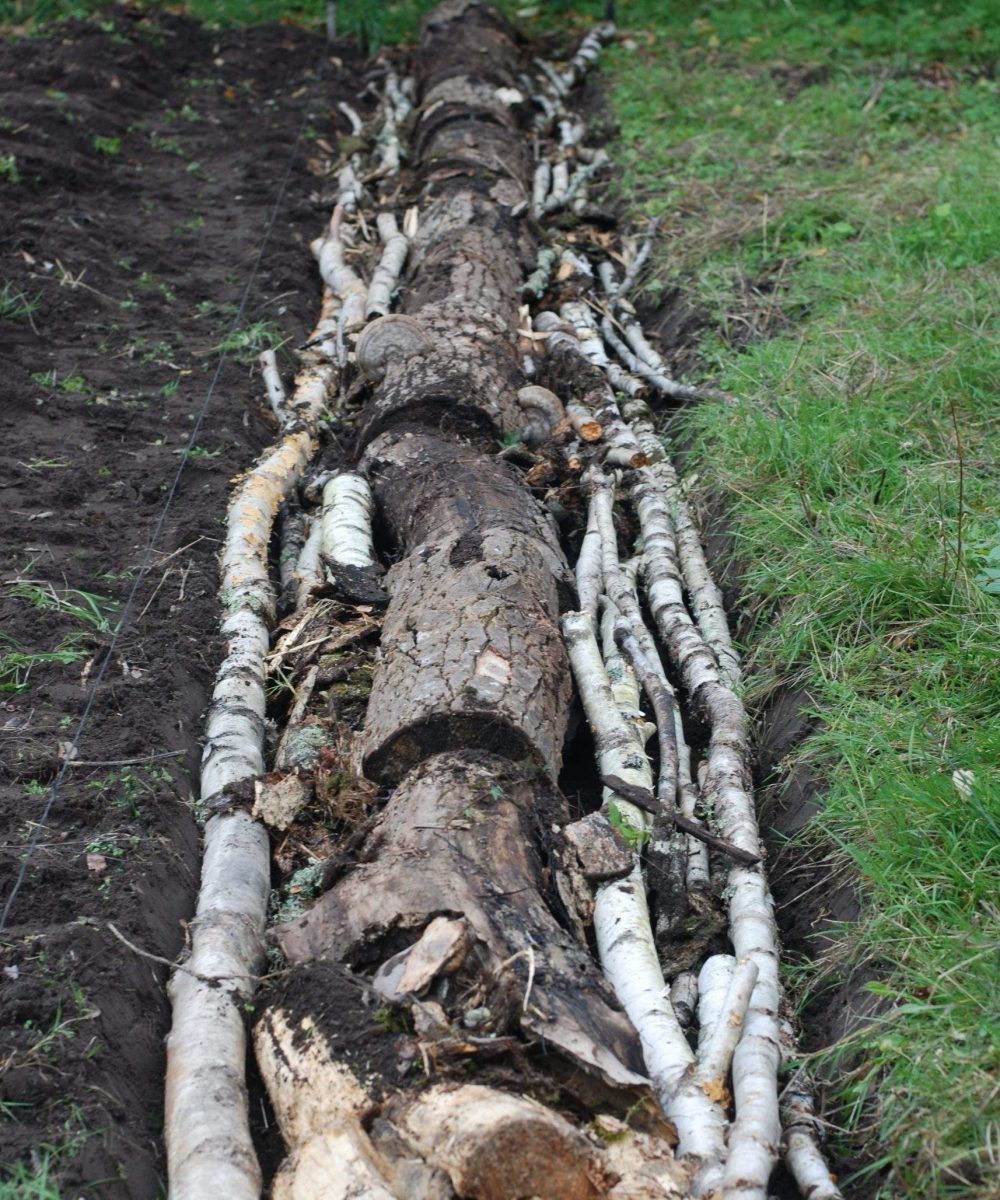ENGLISH
Winter is the time to prepare the garden for next season.
Without going to extremes, I like to plan a few things for my garden, including methods that I have not yet used.
For next year, I had a great desire to start some hugelkultur which is a type of no-dig raised bed.
The term hugelkultur is a German word that simply means mound or hill cultivation. The technique is said to have existed in Eastern European countries for centuries, but it was an Austrian, Sepp Holzer, a specialist in natural agriculture and permaculture, who developed the method in the 1960s. Paul Weathon, an American permaculture author and Holzer’s disciple, helped develop the popularity of the method in many Anglo-Saxon countries.
Today, Hugelkultur is being adopted by more and more gardeners who are happy with the results it brings. But there are also a number of detractors who believe that the method is not valid.
It is true that the place where you live and the type of soil you work with have a very important influence on the construction of this self-fertilising mound.
Generally, these mounds do not work so well in the driest regions such as the south of France. But there are exceptions.
They are constructed with dead wood, branches, grass clippings , manure (if you have some), compost, etc, covered with soil. You can even put seaweeds in them for those who live near the sea. Over time this will create the fertilizer needed for the crops that will be grown on the mound.
The fact is that there is a lot of dead wood on the property around the garden. I thought that the forest wouldn’t mind if I cleaned up a bit and stole some of the small fallen rotten tree trunks to make my mound. I have to say that we have young birches that tend to make a great game of “pick-up-sticks” as soon as there is a bit of wind. And then my husband had to cut up a rather large aspen that had fallen on the communal road, but which was already quite rotten and no longer suitable for firewood.

So here we are, we brought the pieces of aspen, I got some pieces of birch and I started to build my hugel bed.
I realise that I’m going to need a lot more wood, but that’s okay because I still have fallen birch trees that are just waiting to be collected and I have the entire winter to build my mound.
But why would I want to make a mound given the work involved and why do it in winter?
I’m going to use elements which are all around the wider garden, and I know that self-fertilising mound cultivation minimises watering because the wood in the mound, acting as a sponge when it rains enough, retains the moisture. I have already tried to do a type of hugelkultur by putting dead wood with my compost in old barrels where I planted strawberries. They definitely need less watering than those planted directly in the garden. As we are likely to have more and more droughts in the next few years, it seems like a good idea to try hugelkultur, just to save water.
And the mound should attract lots of insects which will enjoy nibbling the organic matter it contains, increasing the biodiversity of the garden.
Then winter is a quieter time for gardeners, so I have time to build my mound without rushing. I also want to take advantage of this period, which is more damp (especially in Sologne), so that the wood of my mound can absorb water as I build it.
As I mentioned earlier, I have everything I need to make the bed, so why not try it?
And then, if I manage to make a mound high enough, it means I will not have to bend down so much to tend the plants, a good thing for my back…
Beware, self-fertilizing mounds is a method that is based on the decomposition of organic matter over the long term, so if you want to try this method, don’t think that you will have a really productive mound during the first few years of its installation.
Also, before you start building a mound, especially if it is high enough (large ones can be made up to 6 feet high), it is imperative to understand that the landscape will be transformed by its placement. It risks blocking the view and it is therefore preferable to put it where it will not be a nuisance. And then you have to study its orientation…
What if it doesn’t work?
Well, I will still have taken advantage of the physical exercise in the garden at a time when we are often in great need of inspiration to do something outside, in connection with nature.
FRANÇAIS
L’hiver, c’est le moment de préparer le jardin pour l’année suivante.
Sans virer dans l’extrême, j’aime bien planifier quelques éléments pour mon jardin, ce qui inclus des méthodes que je n’ai pas encore utilisées.
Pour l’année prochaine, j’avais une grosse envie de me lancer à faire de l’hugelkultur – en français, de la culture sur butte autofertile.
Le terme hugelkultur est un mot allemand qui veut tout simplement dire culture en monticule ou en butte. Cette technique aurait existé dans les pays de l’Est de l’Europe depuis des siècles, mais c’est un autrichien, Sepp Holzer, spécialiste en agriculture naturelle et en permaculture qui, dans les années 1960, a développé la méthode. Paul Weathon un américain, auteur en permaculture et disciple de Holzer a aidé à développer la popularité de la méthode dans de nombreux pays anglo-saxons.
Aujourd’hui l’hugelkultur est adoptée par de plus en plus de jardiniers qui sont satisfaits des résultats qu’elle apporte. Mais il existe aussi une quantité indéniable de détracteurs qui jugent que la méthode n’est pas valable.
Il est vrai que l’endroit ou on vit et le type de sol avec lequel on va travailler ont une influence des plus importante dans la construction d’une butte autofertile.
Généralement, ces buttes ne fonctionnent pas si bien, dans les régions les plus secs comme le sud de la France par exemple. Mais il y a quand même des exceptions.
Elles sont construites avec du bois morts, des branchages, de l’herbe, du fumier (si on en a), du compost, etc, recouverts de terre. On peut même y mettre des algues pour ceux qui habitent près de la mer. Avec le temps cela créera l’engrais nécessaire pour les cultures qui seront faites sur la butte.
Le fait est que j’ai beaucoup d’espace dans mon jardin et qu’il y a tout un paquet de bois mort sur la propriété autour du jardin. Je me suis dit que la forêt ne m’en voudrait pas trop si je faisais un peu de ménage et que je lui piquais quelques petits troncs morts déjà un peu pourris pour construire ma butte. Il faut dire que nous avons de jeunes bouleaux qui ont tendance à faire un grand jeu de mikados dès qu’il y a un peu de vent. Et puis mon mari a dû découper un tremble assez gros qui était tombé sur le chemin communale, mais qui étant déjà bien pourri, n’était plus bon pour faire du bois de chauffage.

Alors voila, on a amené les morceaux de tremble, j’ai récupéré des bouts de bouleau tout aussi endommagé que le tremble et j’ai attaqué la construction de ma butte.
Je me rend compte qu’il va me falloir bien plus de bois, mais ce n’est pas grave car j’ai encore des bouleaux qui ne demandent qu’a être récoltés et j’ai tout l’hiver pour monter la chose.
Mais pourquoi vouloir faire une butte vu le travail que ça demande et pourquoi la faire en hiver ?
Je vais utiliser les matériaux qui sont tout autour de mon jardin, et je sais que la culture sur butte autofertile minimise l’arrosage car le bois dans la butte, agissant comme une éponge quand il pleut suffisamment, garde l’humidité. J’ai d’ailleurs déjà essayé de faire un type de hugelkultur en mettant du bois mort avec mon compost, dans de vieux barils ou j’ai planté des fraisiers. Ils ont définitivement besoin de moins d’arrosage que ceux plantés directement dans le jardin. Vu que nous devrions avoir de plus en plus de sécheresses dans les années a venir, essayer la culture sur butte, rien que pour économiser de l’eau, me semble une bonne idée.
Et puis la butte devrait attirer plein d’insectes qui vont pouvoir se délecter des matériaux qu’elle va contenir, augmentant la biodiversité du jardin.
En suite l’hiver est un moment plus calme pour les jardiniers, donc j’ai le temps de construire ma butte sans me presser. Je veux aussi profiter de cette période, plus humide (surtout en Sologne) pour que le bois de ma butte se gorge d’eau alors que je la construis.
Comme je l’ai indiqué précédemment, j’ai tout ce qu’il faut pour faire ce type de jardinage, donc pourquoi ne pas essayer ?
Et puis, si j’arrive à faire une butte assez haute, je n’aurai pas à me baisser autant pour m’occuper de mes plantations, une bonne chose pour mon dos…
Attention, la culture sur butte autofertile est une méthode qui est basée sur la décomposition des matières à très long terme, donc si vous voulez essayer cette méthode, ne pensez pas que vous allez avoir une butte vraiment productive les premières années de son installation.
De plus avant de se lancer dans la construction d’une butte, surtout si elle est assez haute (on peut en faire des grosses qui font jusqu’à 1m80 de haut), il est impératif de comprendre que le paysage sera transformé par son implantation. Elle risque de bloquer la vue et il est donc préférable de la mettre là où elle ne sera pas gênante. Et puis il faut étudier son orientation…
Et si ça ne fonctionnait pas ?
Et bien j’aurai quand même profité de l’exercice physique au jardin à une période où on a souvent un gros besoin d’inspiration pour faire quelques chose en extérieur, en lien avec la nature.

